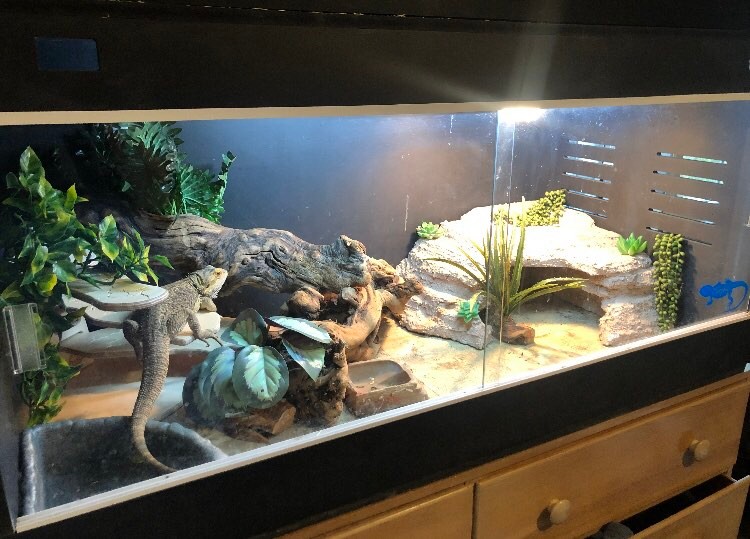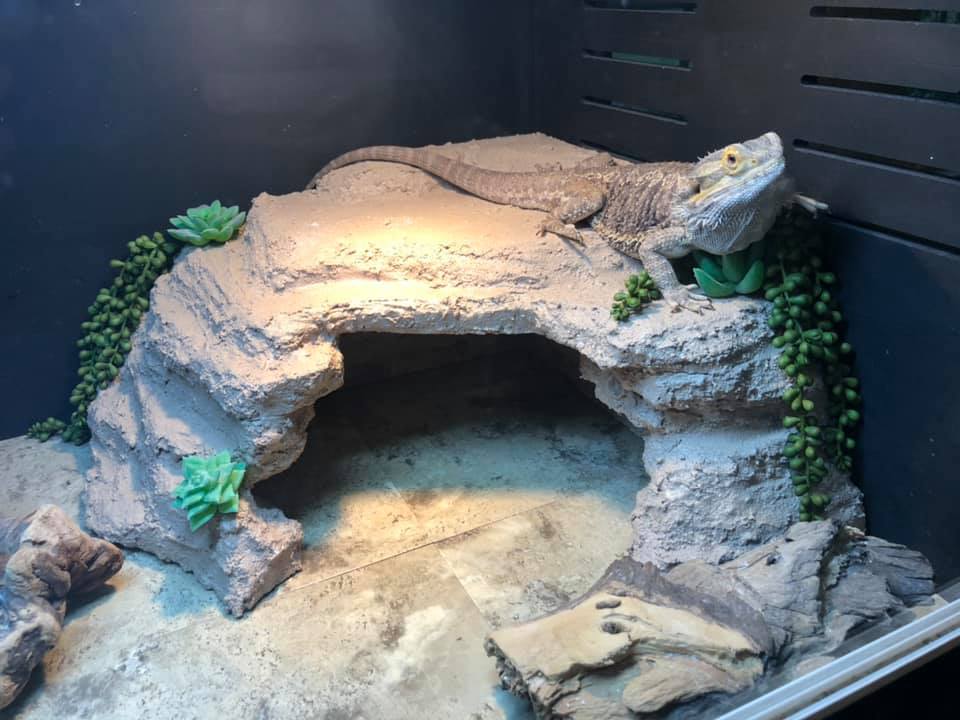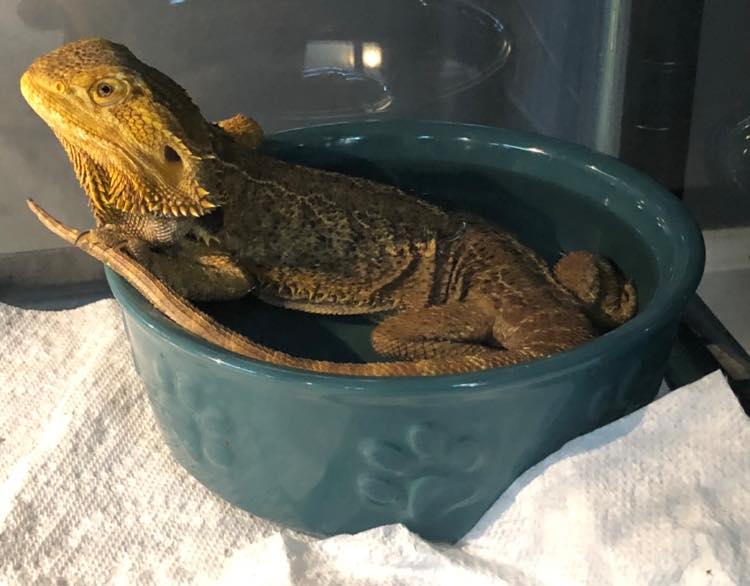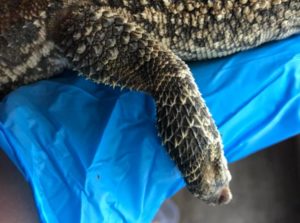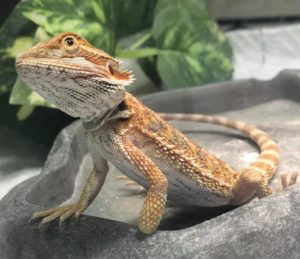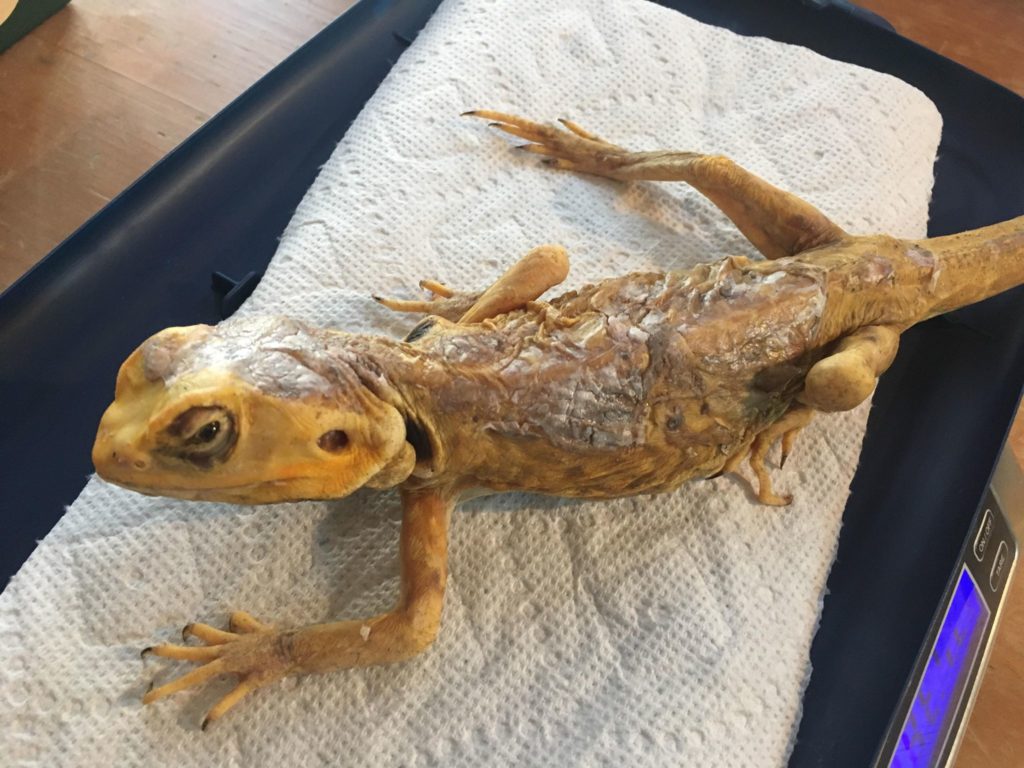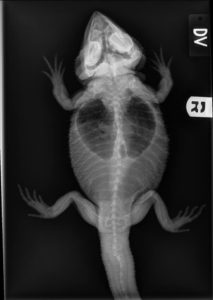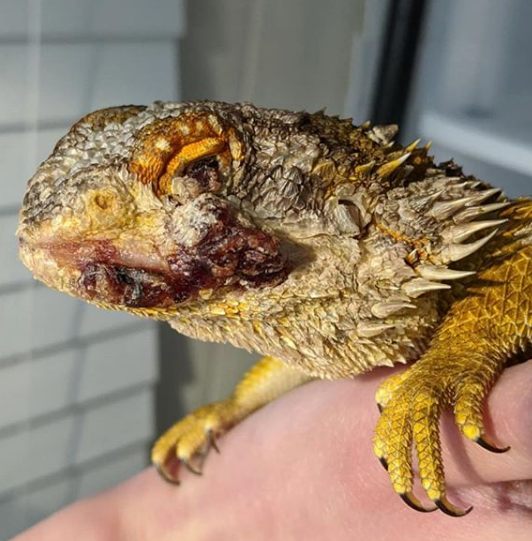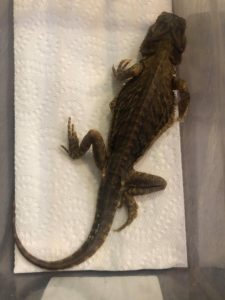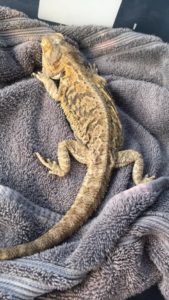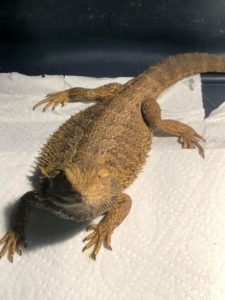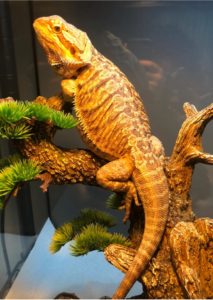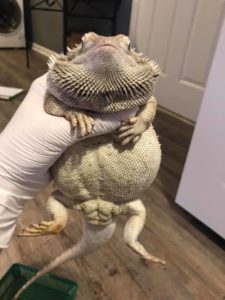Source:Bearded Dragon – BeWild Reptile Rescue

BEARDED DRAGON
Species name: Pogona vitticeps
Lifespan: 8-15 years
Origin: Australia
Adult size: Up to 24 inches in length
Caging
We consider a 40 gallon tank to be the absolute bare minimum for an adult bearded dragon and ideally you should provide them with more space. However, we have found 40 gallons to be suitable for some senior bearded dragons and for dragons with mobility issues. Preferable cage sizes include a 75 gallon tank or a 120 gallon (4x2x2) tank or enclosure. The bigger the better! You can assess how much space your bearded dragon needs by its size and activity level. Young bearded dragons can be kept in smaller enclosures.
Our permanent bearded dragon’s 4x2 PVC enclosure.
Decor
At least one basking spot is an absolute must. Climbing structures can be added for additional enrichment, many seem to enjoy hammocks. Bearded dragons can be pretty active, so it’s preferable to provide them with a decent amount of open space. Some also appreciate an enclosed area to hide and sleep in.
Substrate
Our personal favorite is tile or shelf liner. It is safe, attractive, and easy to clean. Other suitable options include paper towels (must be changed often) or a sand/soil mixture. While reptile carpet is acceptable, it can very difficult to clean and keep sanitary. Some keepers also report instances of their pet’s nails getting caught in the carpet. We recommend that beginners avoid using sand by itself, as it has been known to cause impaction in bearded dragons that are struggling with other health issues. However, we strongly advise against using walnut shell or any type of calcium sand, regardless of experience level. Bearded dragons are more likely to ingest these products, making them much more likely to lead to impaction.
A DIY hide we made for our bearded dragon.
Heating
Bearded dragons should be provided with a basking spot under a heat lamp. A variety of different basking bulbs can be used and you may have to play around with the wattage to get the temperature right. You can use a heat gun (available on Amazon) to reliably measure the temperature. Juvenile bearded dragons should be provided with a hot spot of 110F – 115F. An adult’s basking spot should be 100F – 105F. As long as the temperature stays above 65F, all lights and heating elements can be turned off at night. A nighttime temperature drop can actually improve their sleep cycle and is benefical to their overall health. If the room temperature drops below 65F at night, a ceramic heat emitter or deep heat project can be used, as they produce heat without producing light.
Lighting
In most cases, the ideal UVB light for a beraded dragon is a 10.0 T5 HO UVB linear bulb, popular brands include Arcadia and the Zoo Med Reptisun. Some keepers use T8 bulbs, but T5 bulbs emit stronger UVB and are more appropriate for species that require high levels of UVB. However, if you are mounting your UVB light inside the enclosure rather than on top of a screen lid, you may want to consider using a T8 instead. UVB bulbs should be replaced every 6-12 months depending on type and brand, as they will stop emitting UVB.
One of our rescues utilizing two basking spots.
This ReptiSun T5HO 10.0 24W 22" bulb is one of our favorites! Arcadia is another great supplier of UVB lighting.
Diet
Babies/Juveniles – 80% insects, 20% greens/vegetables. Feed young bearded dragons (under 4 months old) as many insects as they can eat in 15 minutes 2-3 times a day. Offer a salad daily. At 6 months old, they can be fed insects once a day.
Adults – 20% insects, 80% greens/vegetables. Offer a salad daily and insects 2-4 times a week. Monitor their body condition to determine how many insects to offer per feeding. For a healthy bearded dragon we typically offer 3-5 large dubias, 10-15 large crickets, or 5-7 superworms.
The key to providing your bearded dragon with a healthy diet is variety! Never rely on one or two food items, rotate through a variety of different greens, vegetables, fruits, and insects. We’ve provided a bearded dragon food chart below that will help you design the right diet for your bearded dragon.
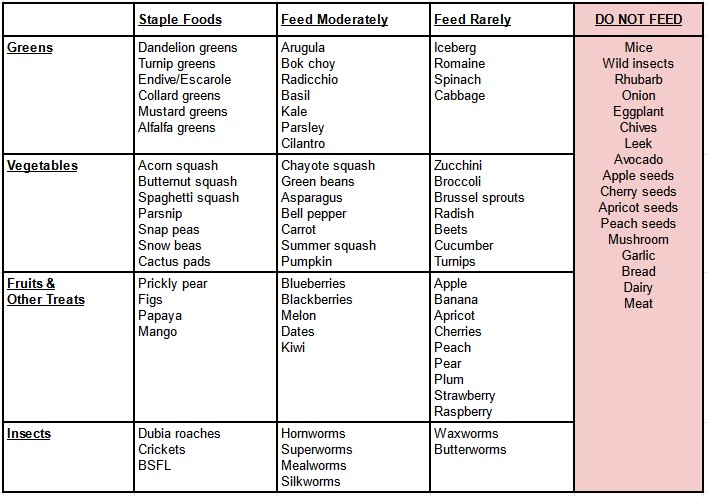
Supplementation
Supplements are typically offered via a powder you use to dust their insects. This is done by adding some of the powder to a bag or cup, and shaking the insects in the powder. Our preferred supplement is Repashy Calcium Plus, which has both calcium and a multivitamin. Repashy Calcium Plus is designed to be used withe very insect feeding. If you are not using Repashy Calcium Plus, for adult bearded dragons you can offer calcium without D3 twice a week and a multivitamin supplement once per week. Juveniles should be offered calcium every feeding, and multivitamins twice a week. We recommend avoiding supplements you add to their water, as this dilutes to the supplement – making it harder to control the amount. Bearded dragons also do not reliably drink water.
Water
A large bowl of fresh water should always be provided. It should be big enough for them to soak in should they choose. Some keepers don’t believe in providing a water bowl. However, we have had many bearded dragons surrendered from owners who chose not to provide one and those animals are always eager to drink when they arrive. They’ll often drink for several minutes!
A bearded dragon soaking voluntarily.
Things You Should NOT Do
Use a red heat lamp: Bearded dragons CAN see red light and this will disturb their sleeping cycles. If you need additional heat at night, use a ceramic heat emitter.
Use a heat rock: While many pet stores will try to sell you a heat rock, they are extremely dangerous. Do not use them for any animal. Heat rocks are not well regulated and can reach temperatures high enough to severely burn your animal. The picture on the right is of a bearded dragon that was surrendered to us after being burned by a heat rock.
Feed a Pellet Diet: While commercially sold pellets won’t immediately kill your dragon, they do not provide the correct nutrition and should never be a large part of your bearded dragon’s diet. They are also full of dyes and other artificial ingredients your bearded dragon doesn’t need to be ingesting.
Cohabitate: Bearded dragons are not social animals and should never be housed with another bearded dragon. They can, and often will, show aggression towards eachother.
Feed Inappropriate Foods: There are many foods you shouldn’t feed your bearded dragon, but we’re just going to talk about some of the food items still recommended by pet stores and uninformed keepers. Avoid feeding your bearded the following foods:
- Pinkie Mice – Feeding pinkies to bearded dragons is a controversial topic because they are very high in fat.
- Romaine and Iceburg – These greens aren’t dangerous, just very low in nutrition.
- Spinach – Spinach is very high in oxalates, which bind to calcium and prevent the body from fully absorbing it.
- Kale – Kale can be fed in moderation, but too many keepers still use it as a staple green. Kale is high in goitrogens, which can negatively impact a bearded dragon’s thyroid.
- Wild Insects – In the words of mothers all over the world, “You don’t know where that’s been!” Wild insects are often infested with parasites that can infect your bearded dragon. Every bearded dragon we’ve gotten in that was found outside has had a serious parasite infection.
Buy a Scaleless/Silkback: Silkbacks, or silkies, are bearded dragons that are purposely bred to be scaleless. The lack of scales will often make their colors more vibrant, so these dragons have become an expensive variation in the hobby. However, their bright colors come at a price. Silkbacks generally have shorter lifespans, are more prone to illnesses, and are more likely to have difficulty shedding. Silkbacks have special care requirements in the form of frequent baths, daily moisturizing, unique lighting requirements, and cage decor that is safe for their delicate skin. A female silkback often cannot be bred without sustaining serious injuries during the mating process. We personally don’t believe silkbacks should be produced at all, but they are definitely not a good choice for a beginner keeper.
Fennel is a bearded dragon that was surrendered to BeWild with severe burns caused by a heat rock.
This beardie’s foot was bitten off by a cagemate he had lived with for years without incident.
This baby bearded dragon’s foot was bitten off by a sibling. Even babies can show aggression!
Biscuit, a silkback that was surrendered to us covered in burns and retained shed.
Common Health Issues
Metabolic Bone Disease: Captive lizards need supplemental sources of calcium, or else they will develop MBD. We see this frequently in surrendered animals, and in severe cases the animals can die. When a bearded dragon doesn’t have enough calcium, its body will start to pull calcium from its bones to support heart and organ function. Eventually, they get so weak they cannot walk properly, stand, or eat. The first signs of MBD include curved legs and weak jawbones, and this can advance as the dragon loses more calcium from the bones. Always see a veterinarian to get an exam on your animal’s condition; most of the time, your vet will give you a prescription liquid calcium to give orally. We personally recommend against purchasing liquid calcium over the counter as it would be hard to dose correctly.
You should also correct your diet to include calcium-dusted insects and gut load your insects with a calcium-rich food. UVB light is mandatory to keep a bearded dragon, and you must use the correct type of UVB bulb. We do not recommend using the small coil bulbs, as they do not produce enough UVB for this species. A T5HO linear bulb provides the best source of UVB, and a T8 is second best. Bulb strength should be at least 10% and they should be replaced every 6-12 months.
Impaction: Bearded dragons kept on particulate substrates, such as sand, can develop impaction if they eat the substrate. If your dragon is kept on sand and is anorexic, losing weight, but has a swollen, bloated abdomen, see your veterinarian for x-rays and treatment. We do not recommend using any sort of particulate substrate for most keepers. Advanced reptile keepers have been able to successfully keep bearded dragons in bioactive enclosures with appropriate sand/soil substrates and heating sources, but this is much more complex than a simple sand tank.
Bumi, a bearded dragon surrendered with severe Metabolic Bone Disease.
The radiograph of a bearded dragon that was surrendered with multiple fractures due to MBD.
Parasites: Bearde dragons can carry many different types of parasites, including pinworms, coccidia, spirochetes, and protozoans. It is common for bearded dragons to have a small level of parasites, this is normal for their gut flora. However, when a dragon is sick or stressed, the parasites can take over and cause diarrhea, weight loss, and anorexia. This can become serious, so bring a fecal to your veterinarian if your dragon is exhibiting the above signs.
Yellow Fungus: Yellow fungus, or CANV, is another highly contagious disease that has no treatment and is fatal. Signs of yellow fungus include yellow patches on the scales, which are first seen near the cloaca and ventral scales. These patches can advance to open sores and can cause severe pain. If you suspect your bearded dragon has yellow fungus, see a vet immediately for a test. An animal with yellow fungus should be kept completely isolated from other animals, as yellow fungus has also been seen in chameleons and iguanas. While there have been some attempted treatments with antifungal medications, no treatment has been shown to be completely effective and for an advanced case, there is no cure. An animal with yellow fungus should be closely monitored for quality of life, and your vet will likely recommend humane euthanasia.
A bearded dragon with advanced Yellow Fungus Disease. Photo provided by Emerald Scales.
Atadenovirus: This is a type of adenovirus, specifically called agamid AdV1, that infects primarily bearded dragons. Atadenovirus is most commonly seen in young bearded dragons, though it can infect older beardeds. In young bearded dragons, signs include emaciation, regurgitation, and a host of neurological symptoms such as star gazing, rolling, twisting, and inability to walk correctly. Young bearded dragons with ADV are usually stunted and most die within a year from malnutrition and neurological decline. If you suspect your bearded dragon has ADV, see a veterinarian immediately to get an ADV test done. This animal should stay completely separate from all other pets, as ADV is contagious and can infect other bearded dragons. ADV affects each bearded dragon differently. While most beardeds will decline within a year, others can live 4+ years. ADV+ dragons that make it past the year mark will typically be thinner and prone to other health issues. If you have an ADV+ dragon, we recommend working closely with an experienced veterinarian to monitor your animal’s quality of life. They may recommend humane euthanasia if the disease is advanced and your animal is suffering.
A bearded dragon surrendered to us with progressed Atadenovirus.
**Hepatic lipidosis:**This is the term for “fatty liver disease,” and is a common malady in overweight reptiles. This is common in bearded dragons fed high-fat diets, such as pellets, waxworms, superworms, and mealworms. Superworms can definitely be used as a part of a balanced diet, but waxworms are especially high in fat and should only be fed sparingly. If a dragon gets too much fat in the diet, the body cannot process it all and fat starts to deposit in the liver. In advanced cases, this causes anorexia, fluid buildup in the body, regurgitation, and death. See a veterinarian if you are concerned your dragon has hepatic lipidosis. They will likely recommend a diet change and feeding consistent amounts of low-fat foods. As a reminder, adult bearded dragons should be eating 80% greens and vegetables, and only small amount of insects and fruits.
Prolapse: Cloacal prolapses can happen in both male and female dragons, but male dragons are more prone to developing hemipenal prolapses. Prolapses are a very serious medical condition and should be considered an emergency situation. Bearded dragons suffering from a prolapse should see a veterinarian immediately. If it is recent, sometimes the vet can push the prolapsed tissue back in and place a temporary suture, but advanced prolapses can become infected and necrotic. Some prolapses will require amputation.
A bearded dragon that recovered at BeWild after being found outside with a rectal prolapse.
Body Condition Score Chart
1 – Emaciated
2 – Underweight
3- Healthy
4 – Overweight
5 – Obese
GET IN TOUCH
- Durham, NC
- 919-442-8238
- info@bewildnc.org
We work exclusively with pet reptiles, amphibians, and invertebrates. If you find injured wildlife, please contact a licensed wildlife rehabilitator.
We are unable to take in yellow-bellied sliders and iguanas due to space restrictions. We are unable to take in red-eared sliders, as they are illegal to own in NC without a Restricted Species permit.
FOLLOW US
Facebook-f Instagram
